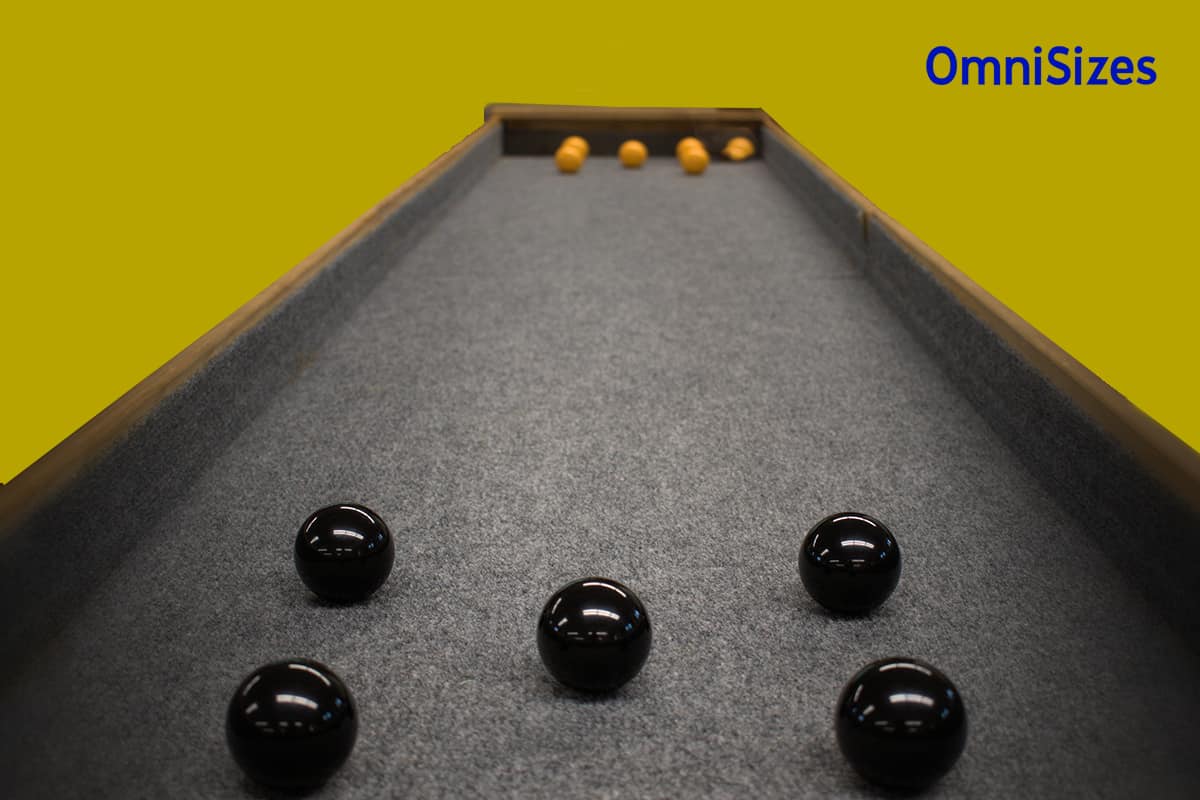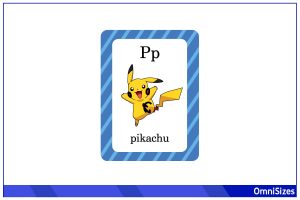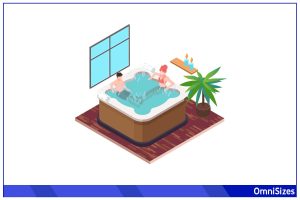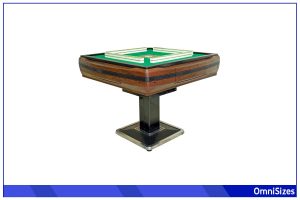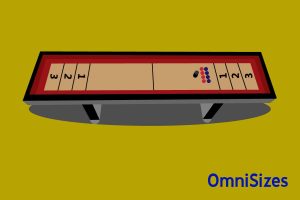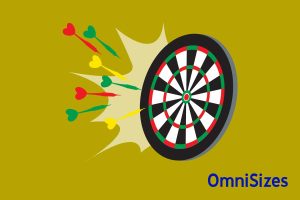Carpetball is a game that combines elements of skill and strategy. Carpetball Table sizes can vary, but they all serve the purpose of providing a unique playing experience. The size of the table is a key factor that affects how the game is played, as it determines the distance players must roll their balls and the playing surface area.
Carpetball tables come in indoor and outdoor sizes, which are usually as follows:
- Indoor: 2 × 12 feet (0.61 × 3.66 m)
- Outdoor: 3 × 15 feet (0.91 × 4.57 m)
Both variants stand around 30 inches (76 cm) high and come with 6-inch (15 cm) pockets on both ends where the balls land.

This guide will briefly describe carpetball as a sport, as well as provide a deeper explanation of carpetball table sizes.
What Is Carpetball?
Carpetball is a popular indoor game where players roll billiard balls across a long, narrow table. The game is typically played in recreation centers, camps, and game rooms.
The objective of carpetball is to knock all the opponent’s balls into the opponent’s sunken pocket using the black ball. Players take turns rolling the black ball towards their opponent’s balls. The game continues until one player clears the table of the opponent’s balls.
Carpetball doesn’t have a complex scoring system. The winner is simply the player who knocks all their opponent’s balls off the table first.
While the standard game is widely played, variations exist to keep it interesting. These can include different ball arrangements, multi-player formats, or unique rules like “bank shots only.”
In some areas, carpetball leagues and tournaments bring together players for more competitive play. These events can range from local to national levels and are a great way to meet fellow enthusiasts.
Standard Carpetball Table Dimensions
The most important piece of equipment for carpetball is the carpetball table. Whether you want to build one for home use or purchase a premade table, you should know the typical carpetball table sizes. These tables are available in two size variants: indoor and outdoor.
Indoor Carpetball Table Size
As the name suggests, indoor carpetball tables are used for indoor play. This usually means that the table is smaller than its outdoor counterpart but no less fun to play on.
The entire table from corner to corner measures 2 × 12 feet (0.61 × 3.66 m). This includes 2-foot × 6-inch (0.61 m × 15 cm) sunken pockets on each end. The playing surface of the table—i.e., where the balls are placed prior to play—measures 2 × 11 feet (0.61 × 3.35 m).
The height of the table varies, depending on what the players find comfortable. However, a common height used for carpetball tables is 30 inches (76.2 cm).
Outdoor Carpetball Table Size
Outdoor carpetball tables are slightly larger than indoor tables. This is due to fewer size restrictions outdoors. As such, you can construct an outdoor carpetball table to any size you want, but there are usually standard sizes to follow.
From corner to corner, the rectangular carpetball table measures 3 × 15 feet (0.91 × 4.57 m). Again, this includes 6-inch sunken pockets on each end, so the playing surface measures 3 × 14 feet (0.91 × 4.27 m). The height of the table is also around 30 inches.
Space Requirements for Carpetball Tables
While the size of a carpetball table is important, players should also consider how much space is required around the table for comfortable play.
1. Room Size
When considering the room where the table will be placed, you need to account for player movement and game dynamics. A room length of at least 22 feet and a width of 10 feet (6.71 × 3.05 m) is recommended. This allows players to stand at the ends comfortably and walk around the table without obstruction.
2. Clearance Space
Beyond the table dimensions, additional clearance space is necessary. A minimum of 5 feet (1.52 m) of free space around the entire table is the norm. This provides players enough room to take shots without any restrictions in their movements.
3. Flooring
The floor should be level to keep the table steady. Carpeting or rubber mats can reduce noise and protect the floor from any dropped balls. Ensure the flooring material can withstand the weight of the table and the dynamic play. Outdoor tables may require shims to maintain stability on uneven grounds.
Custom Carpetball Table Sizes
Carpetball tables come in a standard size, but custom sizes are available to fit different spaces and preferences. This flexibility allows for personalized gaming experiences in various settings, from small apartments to large recreation centers.
Determining the Right Size
To determine the right size for a custom carpetball table, consider the available space. There should be enough room for players to move and for the balls to roll freely. Measure the designated area, leaving extra space for players to stand and move comfortably around the table. Follow the space requirements for carpetball tables as described above.
Length Variations
While the standard carpetball table is 12 feet long, custom tables can be shorter or longer. Shorter tables (around 10 feet or 3.05 m) suit smaller spaces and younger players, while longer tables (beyond 15 feet or 4.57 m) can increase the game’s challenge and are suitable for larger venues.
Width and Height Adjustments
Width and height can also be customized. A wider table can offer a different game dynamic, and height adjustments can make the table more comfortable for players of different statures or those in wheelchairs. You may also want to adjust the number of balls used when playing on a wider table.
Carpetball Accessories
Enhance your carpetball game with the right accessories. From balls to protective gear, these additions can make the game more enjoyable and your table last longer.
Balls
The core of carpetball, apart from the table and its dimensions, is quality billiards balls. Consider size and weight for the best experience. Some prefer unique designs or colors for a personalized touch.
Table Carpet
If you’re constructing your own carpetball table, you’ll need to cover the playing surface and side walls with carpeting. Felt is the optimal choice, but faux suede or fleece can work in a pinch.
Table Cover
Protect your carpetball table with a durable cover. It guards against dust and spills when not in use. Look for waterproof materials if the table is outdoors.
